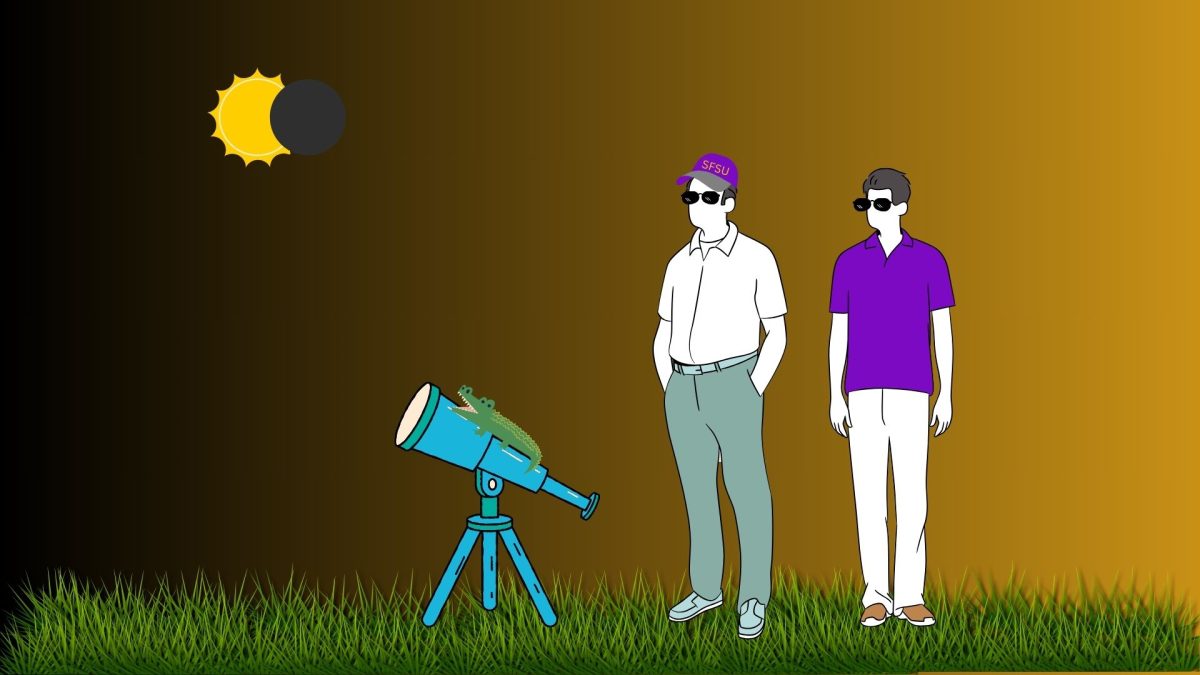Monday’s forecast at San Francisco State University promises sunny skies, wafting winds and guaranteed sights of a solar eclipse.
Between 10 a.m. to noon on April 8, a total solar eclipse will be viewable across North America, meaning the moon will completely cover the sun. The shadow of totality will be cast over New York, then south toward Dallas and across Mexico, meaning residents on the East Coast and southwest will have a better view of the eclipse. Students and faculty at SFSU will see a partial solar eclipse with about one-third of the sun appearing covered.
A total solar eclipse occurs when the moon fully covers the sun and only the corona, the outermost layer of the sun’s atmosphere, is visible. The last total solar eclipse occurred in August 2017, and its trajectory went across the United States from Washington through the Midwest and South Carolina. The next solar eclipse visible in the United States won’t happen for another two decades.
“The corona looks like a spider web made out of light that’s floating on top of like some water because the electromagnetic field of the sun is constantly moving,” said Juan Naranjo, a physics graduate student and treasurer of Students of Physics and Astronomy: a Community for Everyone (SPACE). “This is a very beautiful, unique sight. You can see pictures of it online, but nothing really beats seeing it with your own eyes.”
During the 2017 eclipse, Naranjo drove to Washington with his brother and mother for a better experience. Naranjo explained it as seeing a “360-degree sunset” with the light bouncing off the moon, creating this reflection. Naranjo went to a park where other people waited to see the sun fully covered.
Once the sun was completely covered, Naranjo thought about how small humans are in comparison to the vast universe. As a physics student, he quickly fell in love with space and encourages people who haven’t experienced a total solar eclipse to drive or fly to a location to get the full experience.
“When the sun went out, it was very quiet. All the animals were quiet, And then some crickets started to chirp,” Naranjo said. “If you imagine a caveman seeing that like thousands of years ago, it would make sense why they would start worshiping the sun as a god or something.”
Naranjo will not be traveling to see the eclipse in its totality on Monday, but Tonya Peshel, the event coordinator for SPACE, has purposely booked a trip to Illinois to celebrate her niece’s birthday while simultaneously getting a better view of the total eclipse.
Peschel wishes to share this experience with her family and hopes they will also cherish it.
“There’s one place in Illinois called Carbondale, where it’s the only place in the country where this eclipse’s path is intersecting with the one from 2017,” Peschel said. “It’s at least a five-hour drive so I don’t think a six-year-old will be able to handle that. We’re still gonna get like 97% coverage where they live so it’ll still be fun.”
Peschel, an astrophysics student, said that as a kid they felt a connection with the stars, which gave them “a sense of wonder.” Their dream is to work for NASA and contribute to space exploration in the future.
Peschel mentioned there will be two telescopes at SFSU during the eclipse so students and others can enjoy the celestial event.
“Any students or anyone from the public can look through telescopes,” Peschel said. “We have telescopes that have special filters so that you can look at the sun safely.”
The telescopes will be located in front of Thornton Hall and the quad. Adrienne Cool, a professor of physics and astronomy at SFSU, will move between the two stations to provide students with a limited number of protective glasses so they can safely stare directly at the sun.
Cool stated that the observatory in Thornton Hall won’t be open because the telescopes will provide the same experience and won’t force students to go up to the tenth floor. Placing telescopes at campus locations with more foot traffic will lead to more engagement and a better experience overall.
“It might feel a little eerie because, over time, the moon is gradually passing in front of it, so there’ll be like this bite out of the sun,” Cool said. “If you don’t actually use special glasses or go to the telescopes, people might feel like it’s cloudy, even though it’s not cloudy. It’ll be like, ‘It feels like something off.'”
Cool explained that mathematics and the laws of physics have allowed astronomers to calculate when the next solar eclipse is happening. Understanding the orbits of the moon and Earth around the sun enables us to predict the precise timing and location of the path of totality.
Even before the age of digital technology, astronomers could still predict these outcomes. Ancient Greeks were able to do so, using a machine called the Antikythera Mechanism.
“Every once in a while, the alignment is just so that it [the moon] does pass in front of the sun, and this is a special day today,” Cool said. “The next time it’s going to happen for us here in San Francisco is in 20 years, so check it out.”
The eclipse will peak at about 11:13 a.m., so don’t miss out. Otherwise, you’ll have to wait until 2044 to catch the next one.











